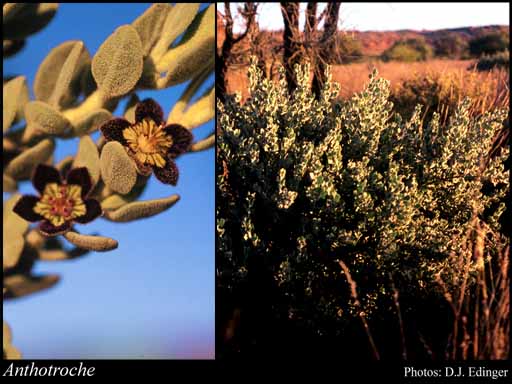- Reference
- Nov.Stirp.Dec. 1:6 (1839)
- Name Status
- Current







Scientific Description
Common name. Anthotroches. Family Solanaceae.
Habit and leaf form. Shrubs; resinous, or not resinous. Plants unarmed. Stem internodes solid. Helophytic, or mesophytic, or xerophytic. Leaves alternate; spiral; ‘herbaceous’, or leathery; petiolate, or subsessile; non-sheathing; not gland-dotted; simple; epulvinate. Leaf blades entire; elliptic, or ovate, or obovate, or orbicular; pinnately veined; cross-venulate. Leaves without stipules. Leaf blade margins entire. Leaves without a persistent basal meristem. Leaf anatomy. Hairs present; glandular hairs absent, or present. Extra-floral nectaries absent. Stem anatomy. Secondary thickening developing from a conventional cambial ring, or anomalous; from a single cambial ring.
Reproductive type, pollination. Fertile flowers hermaphrodite. Unisexual flowers absent. Plants hermaphrodite. Entomophilous.
Inflorescence and flower features. Flowers solitary, or aggregated in ‘inflorescences’; in fascicles (or clusters). The terminal inflorescence unit cymose. Inflorescences terminal, or axillary. Flowers pedicellate, or sessile; ebracteate; ebracteolate; small to medium-sized; regular; mostly 5 merous; cyclic; tetracyclic. Free hypanthium absent. Hypogynous disk present. Perianth with distinct calyx and corolla; 10; 2 -whorled; isomerous. Calyx present; 5; 1 -whorled; gamosepalous; blunt-lobed; broadly campanulate, or cupuliform, or cyathiform; regular; persistent; non-accrescent. Calyx lobes narrowly ovate. Corolla present; (4–)5(–6); 1 -whorled; gamopetalous. Corolla lobes markedly shorter than the tube to markedly longer than the tube. Corolla contorted and plicate (volutive, induplicate); rotate, or campanulate (broadly), or funnel-shaped; regular; white (both tube and lobes and then rarely), or yellow (tube greenish-yellow), or violet (lobes). Androecial members definite in number. Androecium 5. Androecial members adnate (epipetalous, on the tube); all equal; free of one another; 1 -whorled. Androecium exclusively of fertile stamens. Stamens 5. Staminal insertion near the base of the corolla tube. Stamens all inserted at the same level; remaining included; all more or less similar in shape; isomerous with the perianth; oppositisepalous (at the base of the corolla tube). Filaments not appendiculate; hairy. Anthers separate from one another; basifixed; dehiscing via pores to dehiscing via short slits (‘semi-circular slit’); extrorse; unilocular; tetrasporangiate. Pollen shed in aggregates, or shed as single grains. Gynoecium 2 carpelled. The pistil 2 celled. Carpels reduced in number relative to the perianth. Gynoecium syncarpous; synstylovarious to eu-syncarpous; superior. Ovary plurilocular; 2 locular. Gynoecium oblique. Ovary sessile. Gynoecium stylate. Styles 1; free; attenuate from the ovary; apical; becoming exserted, or not becoming exserted. Stigmas 1–2; very shortly 2 - lobed, or 1 - lobed; capitate. Placentation axile. Ovules 20–50 per locule (numerous); non-arillate; anatropous, or hemianatropous.
Fruit and seed features. Fruit non-fleshy; not spinose (smooth); dehiscent; a capsule. Capsules septicidal, or loculicidal, or valvular. Fruit 20–100 seeded (numerous). Seeds endospermic. Endosperm oily, or not oily. Cotyledons 2. Embryo straight, or straight to curved.
Etymology. From the Greek for "flower" and "ball, disk, or wheel".
Taxonomic Literature
- Australia. Bureau of Flora and Fauna 1982. Flora of Australia. Volume 29, Solanaceae. Australian Govt. Pub. Service.. Canberra..
- Grieve, Brian J.; Blackall, William E. 1982. How to know Western Australian wildflowers : a key to the flora of the extratropical regions of Western Australia. Part IV. University of W.A. Press.. [Perth]..